
My name is Oleg, I am a remotely working DevOps engineer at Flant, and in this article I will try to convince you that jogging is the best choice for a remote person.
Recently, the total number of kilometers I have covered has exceeded the figure of 3000. But that was not always the case. Since childhood, I was categorically unsportsmanlike. Physical education at both school and university aroused my strong disgust.
Sources No. 1: historical fencing
The first physical activity that I took up seriously was historical fencing:

We put on “equipment” - quilted protection and hand-to-hand helmets, and beat each other with “chambers” - pieces of a polypropylene pipe wrapped in several layers of foamed polyethylene. Gradually, elements of iron equipment were added to the equipment (up to forty kilograms of total weight), and now the chambers were replaced with steel training swords, and the fights became completely comic.
Bugurt is a type of group fights that have almost completely supplanted tournament fencing.
“Of all the sports, we chose one in which the five of us can beat one,” - the words of the famous boogurtman.
By the way, this brave halberdist in “vidra” (the slang name for the helmet is “tophelm”), which hit me at the very beginning of the gathering, is Dima Sibilkov, an engineer of our company, who, by the way, recently published the first article on the hub. In the next meeting, I will knock out his hand.
It was more fun than sporty . Classes were held in dusty dumb rooms, no one thought about any special physical exercises. What is it - we almost never did a warm-up. Gradually, military-applied fencing was added to the historical fencing (fights on knives, mockups of sapper blades, carbines).
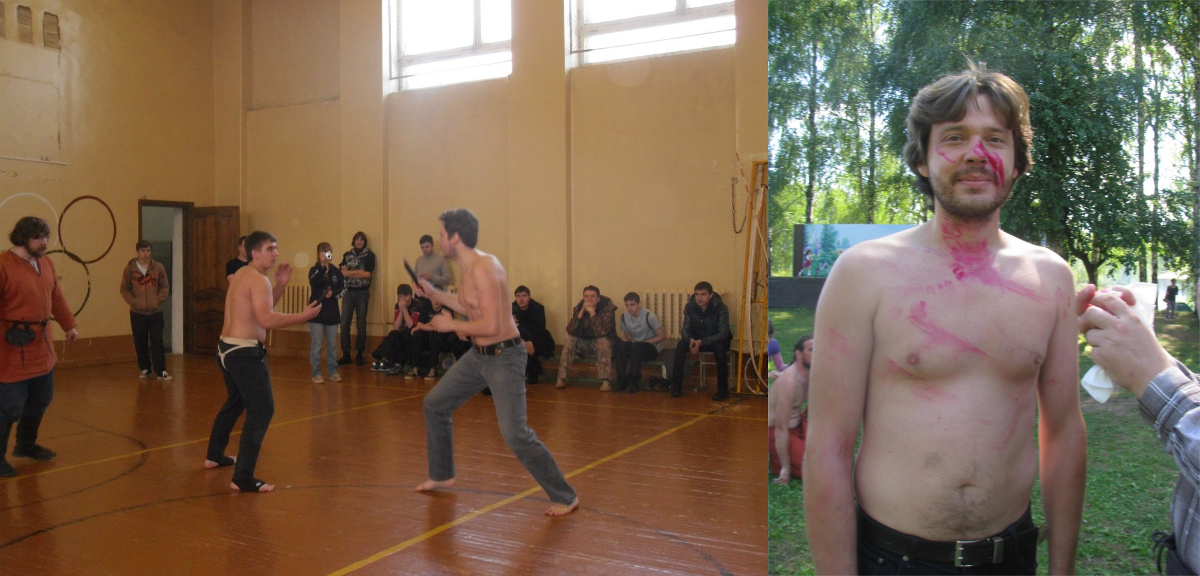
In the photo on the right - traces of paint applied to rubber knives to count lesions and accrue points. Judging by the nature of the wounds, I should rather be dead.
But over time, the direction of historical fencing fizzled out: tournaments became less representative, many clubs disappeared, and in the end it was not as interesting as before ...
Sources No. 2: Rugby
A holy place cannot be empty. Once, while driving past a stadium not far from home, I saw guys running with an oval ball ... After a couple of weeks, I already played my first right-handed game for the Kostroma Sparta team in the Rugby Golden Cup.
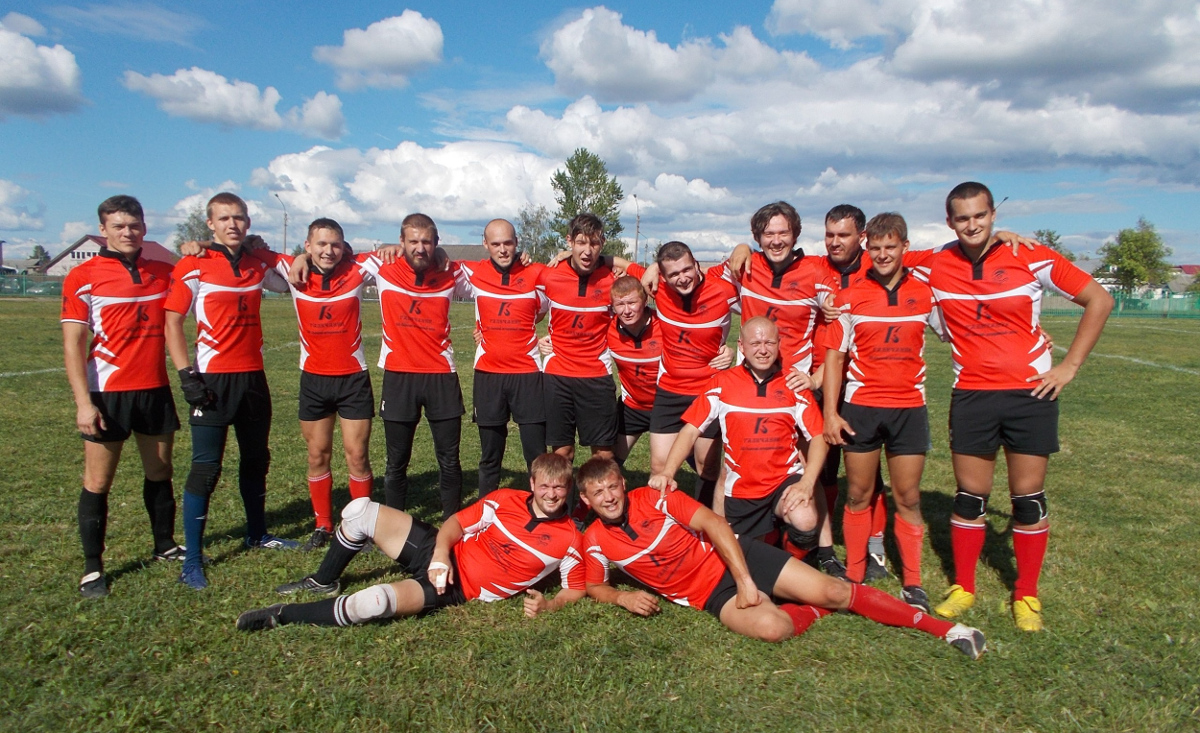
In the middle of the photo, by the way, again the same Dima Sibilkov. He is from Rybinsk, and we were friends with their rugby team “Bourlaki” and often invited them as legionnaires.
Rugby lessons coincided with my first work in a remote format. A couple of times a week in the evenings, closing the task, I went to training, and it was fun. Rugby lessons helped me make up for the shortage of human communication in remote work . The very thing that Sergey Goncharuk (the manager of my team) spoke about in his recent report when he mentioned “conversations with the cooler”. In the end, the lack of human communication with other team members (for three years I have not seen the faces of any of them) has become one of the main reasons for leaving ...
And in winter, the training teams moved to the other end of the city: it began to cause inconvenience. A shift in training toward working in the gym has reduced fun and motivation. It became difficult to get out to training, and I decided to try to do kickboxing (the ambitions of the martial artist who remained from the fencing class played). I found a good club, and signed up for training, but in the end, the problem of motivation (to pack, go) remained. Training could not be done regularly.
For Sparta, I played the season of 2014 and half of 2015. Then there was a rather severe knee injury in the game with Ivanovo “White Sharks”. I also broke my nose twice and helped the children injured in games and training several times: dissections, broken fingers, dislocations, fractures of the clavicle, thighs and lower leg. By the end of 2015, while doing a aching knee massage, I decided that although rugby is certainly a fun game, and the people on the team are great, the risk of injury and loss of life, depriving the family of earnings, is too great ...
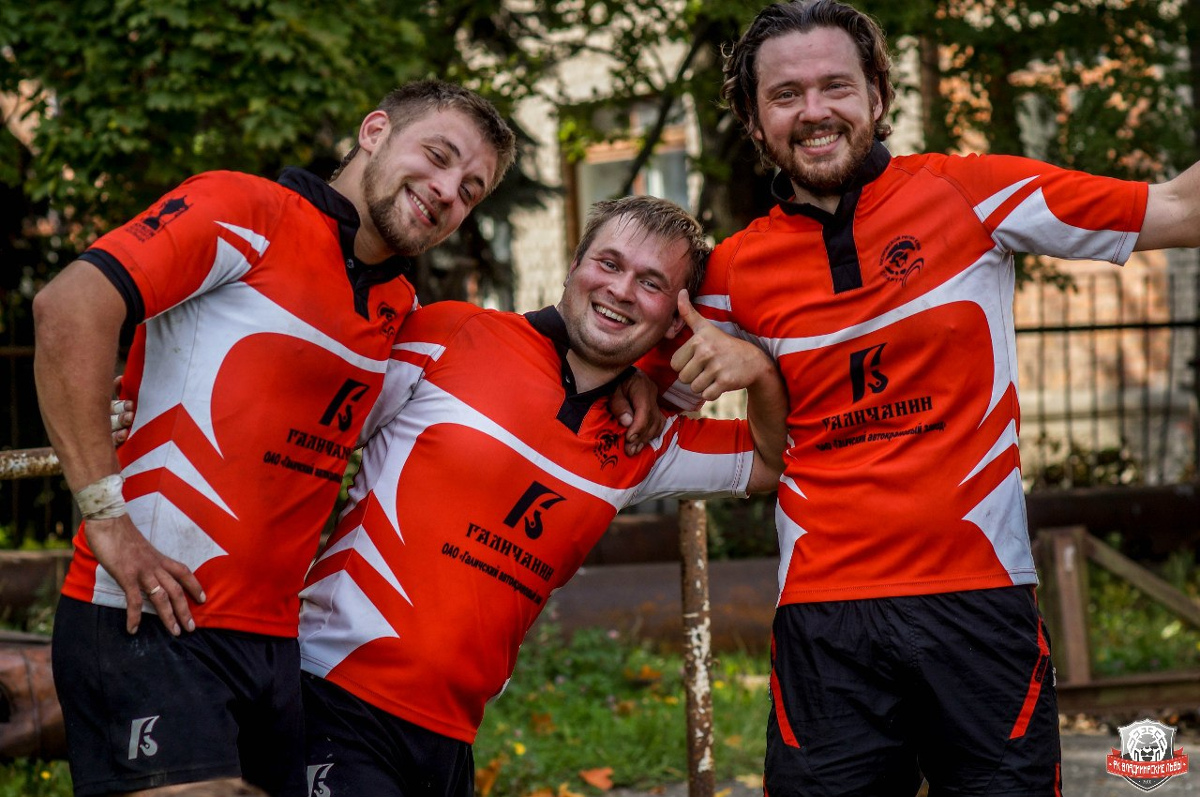
Away game with Vladimir Lions, end of the first half. In this photo, my eye is broken and my nose is broken. Ahead of another half of the game and the “third half” (general friendly drinking party). By evening, the eye will stop opening.
And so it happened that my good friend Andrei Mikhalych ran his next half marathon in the fall of 2015, which he colorfully shared over a beer at the meeting. A cool T-shirt and a medal from the race were also very personal. I'm on fire!
Sources No. 3: Running? Still not: cycling
In the spring of 2016, when the snow fell, I bought running shoes and for two and a half months I got ready and ran the half-marathon (21.1 km) of Zdorovo, Kostroma on Russian Day on June 12.

The first mass run struck the atmosphere . When a bunch of people are running with you, and another bunch is standing on the highway and supporting, waving and giving out pyatuni - emotions go off scale. On this emotional wave, I showed a great time for the first run (1:53:05) - much higher than what I could count on.
Now, looking at the pulse with which I went the distance, I am very surprised ... but the main test awaited me the next morning, with a peak on the second day after the race.
It was something like this (only without bloody nipples)
Meanwhile, Andrei Mikhalych was preparing to run his first Moscow marathon. I also made a training schedule for the marathon, and following it, I got a runner’s knee injury (nothing serious - we’ll come back to that). At that time, I decided that this was an exacerbation of last year's rugby injury, went to a fairly well-known medical center that received my employer's VHI, and the orthopedic surgeon, having previously sent him for an X-ray of the knee, suspected osteoarthritis, saying that if I continued to run, I would lose my knees .
It was a blow below the waist - I was very depressed. And then a fat bike appeared in my life. I must say that the bicycle is my old love, since my school years. “Bear”, “Stork”, “Ukraine”, “Desna”, then the unpretentious MTB Stels, which at that time seemed incredibly cool, and “to work on a bicycle” when the weather permits. And a fat bike allowed to do this year-round!
The winter of 2016-17 became one of the most eventful and interesting of all winters.
Wading through the snowy paths at dusk, seeing the glow of the city's lights on half the horizon, is a special aesthetic pleasure.
That same feeling when, leaving work with a bicycle on your shoulder, you decide to ride a bit and ...
- instead of a direct road home you go to the city center, and from there - to the embankment,
- there you see a path on the Volga ice trodden by fishermen and, obeying a sudden impulse, turn off and go along it into a frosty sunset,
- and there you get up on the track of a snowmobile that goes to the mouth of the river, which flows near your house, you screw on snowmobiles,
- then you get to the embankment and go to kindergarten for the youngest daughter,
- you take a cheesecake, tie it to a bicycle and carry it (observing all safety rules!), proud of it under the admiring glances of other children, home ...

It was decided to devote the 2017 season to cycling. I even purchased a ligade to ride brevet (see my review of a 200 km brevet on a ligade and a comparison of ligade vs bike) . But the summer turned out to be so cold and rainy that even half of the plans could not be realized . A pair of bicycle marathons, three brevets, several long "weekend pokatushek".

In the fall of 2017, I got a job at Flant. It was in a sense a jump above my head - a challenge to my professional skills. The desire to show oneself from the best side, as well as a huge number of new, advanced, interesting things at work, made me stay at the terminal for a long time, and the home office deprived me of the need to “work on a bicycle”.
I did not give up cycling, but without goals and a clear training plan , I often preferred the next training to the task of sorting out the Flannel CNI in Kubernetes, for example.
"Nast got up" - the most anticipated event in the fat season. You can ride anywhere, anywhere. That is generally everywhere.
In training, I often just simply rolled somewhere spontaneously, drove out of town, got into a snowmobile rut and pedaled, completely confident that fet would take me out of any, deepest distance, wherever I pulled us.

I still think that “to work on a bicycle” is a great option for office workers , especially for IT's. Arrive 20 minutes before the start of the working day, leaf through the 10 minutes of the habru until the body has cooled, then go to the server room, change into dry clothes (perhaps these are the features of secretion of my body specifically, but changing clothes after physical activity - provided that before it had a shower and deodorant - enough to feel the body fresh and not annoy colleagues with unpleasant odors), work out the day, and roll it in the evening for pleasure. But after switching to a remote site, this mechanism starts to fail.
Running: start
It became clear that something needs to be done with this. And so, at the beginning of 2018, I heard about trailrunning. Already several of my friends started running. Elton, Markoth, Crimea X Run, mad fox, Golden Ring Ultra Trail - all this sounded new and interesting.
It was decided to return to running, but to do everything right, "wisely":
- I bought good running shoes and a cool wrist heart rate monitor,
- I read a bunch of articles on the technique and physiology of running, training methods,
- made a list of target races and built a preparation plan for them ...
- ... and when the snow came down, went on the first run.
21 km
After returning to run, I also overcame my first half (again, “Great, Kostroma”) two months after the first run. He overcame much more slowly than the first time, but the goals were different.
On the run, it was decided to go the distance "in strength", without excessive overvoltage, in order to avoid injuries. In the absence of sports achievements, I decided to shoot a very amateur video about collecting “five” during the race. This idea was prompted by the name of the race - "ZdorOvo, Kostroma."
34 km
The first big goal - the T30 distance (34 km) on the Golden Ring Ultra Trail (GRUT) race on the 20th of June - passed quite easily and, most importantly, without injuries. My friend Andrei Mikhalych ran the T100 (107 km) in the same race. Then it seemed to me something extraordinary.
In fact, the T30 distance is the funniest in this event. Super-endurance is not necessary, the pain does not have time to come - everyone runs cheerful, on the positive. If you want to try trailranning, focus on this distance. You can read my review of this race here .
47 km
The second big goal - the MustaTunturi race from RRUNS - was decided to be combined with a car trip to the Murmansk region. The race was declared as mountain. At my distance, the climb was supposed to be 900 m ... However, the Murmansk rains made their adjustments to the race: some of the places along which the main track was laid turned out to be impassable, so the organizers allowed the athletes to reserve.
That day, instead of 34 kilometers, which were initially registered, it happened to overcome 47. So, without running a single marathon before, I conquered the ultra-marathon distance, and this fact completely repelled any reverence for the races with the prefix “ultra” .
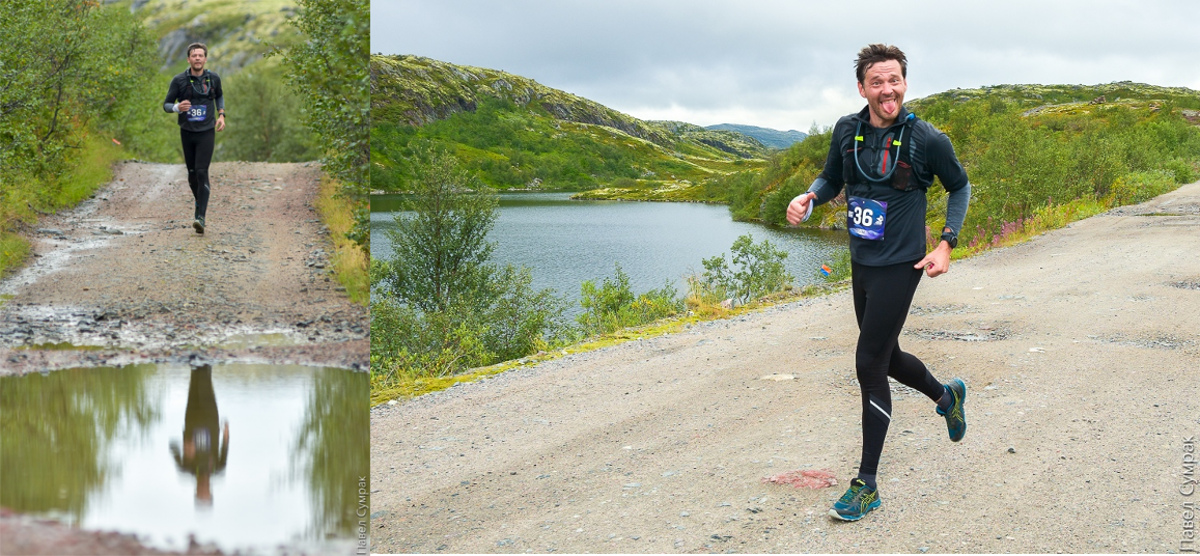
A hundred kilometers teased and haunted. Upon returning home, I took a new training plan and began to prepare for the next jump above my head: to earn on the GRUT T100 in the 2019 season. You have no idea what a person who has a plan can do and he should:
- 6 workouts per week,
- volume - more than 100 km per week at peaks,
- autumn, winter, rain and cold ...
... I made a plan. Gradually, it became a habit, a way of life .
Running: T100
The first serious test of strength took place at the end of May 2019 - the Elton Night Ultra race (84 kilometers of semi-desert) , where I ran out of 9 hours.
The Elton Ultra team has traditionally cool videos. My wife and I are on the 27th second.
This race confirmed the correctness of the course taken and that the training plan is working. But this actually was not so important: my wife and I got Elton - the largest salt lake in Europe.
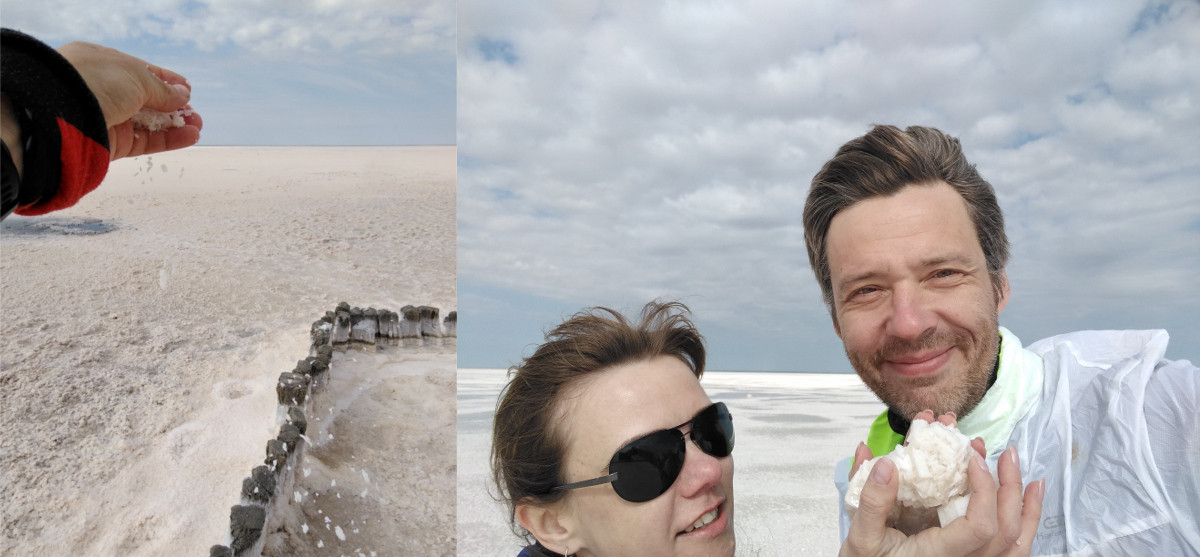
This unique place somehow appeared on the borders of our information space and aroused natural interest. But there was no reason to get together. And they became the night race around this lake, which fit perfectly into the preparation plan. As a result, it came to understand that “running tourism” is, in principle, very good .
Then there was the CrazyOwl night ultra-race - 50 km. Starts from the Running Heroes Russia team have their own special atmosphere, which gathers a large running party. It is worth going there even for communication. A large friendly company gathered from Kostroma, and it was great. Also, my daughters participated in the children's starts of this race.

(left) Me and Andrei Mikhalych after the finish. (right) Alena after overcoming the children's race. The main prize for little runners is ballooning.
And now the great and terrible ... Golden Ring Ultra Trail T100 - 108 km of forests, fields and swamps that I ran out of thirteen hours.

All who finish this race are given wooden medals, on which the blacksmiths burn the stigma of the distance. A very beautiful and symbolic tradition.
Those interested can read my report on this event. The main revelation after taking the T100 was that after this race I felt many times better than after the first half marathon :
- There was no feeling that a train hit me. Nothing hurt.
- The need to get out of the chair did not cause denial - anger - bargaining - depression and acceptance. The stairs were not terrifying.
- My first recovery training - 5 km at an easy pace - I did the very next day.
Subtotals
All of the above is given as an illustration to explain the following statements (which otherwise might seem unfounded):
Availability
Above all, running is extremely affordable. You do not need sparring partners, a team, training equipment, equipment, gyms, to go somewhere, to keep up ... You just need to put on a running uniform, sneakers and leave the house.
Here lies the first problem, which can be formulated as follows:
“Any sports simulator installed at home will eventually turn into a clothes hanger.”
Sooner or later, you will want to get dirty, miss a workout, stay at home, watch a movie, stay at work ... Especially - stay at work. After all, the bulk of IT'shnikov are enthusiasts of their craft. These are people who love technology, with whom they work ...
If you allow such people to do what they love from home, they will do it around the clock, to the detriment of everything else. And here we are gradually approaching the following important point:
Running events
This industry is currently at the peak of development. There are a great many races: in various places, with all sorts of distances, focus, your chips and status. Perhaps there are more than events in other sports.
Choose a start, set a goal, draw up a preparation plan and follow it. It’s good if the goal is slightly higher than current opportunities . And then the understanding will come that, systematically not fulfilling the plan, you simply will not run the race as it should. M is motivation . After all, now you already imagine, “what can a person who has a plan do it and he follows it?” ..
Running tourism
And another important point is the geographical distribution of starts. From Kaliningrad to Vladivostok, from Murmansk to Gelendzhik:
- They wanted to visit Tula, but there was no reason? Tula marathon “Shield and Sword” - a running tour of the city in good company!
- Have you heard a lot about the small town of Myshkin? How about going through the museums there and running through the Half Hills Half Marathon along the way?
- Constantly hear the word Valdai, but faintly imagine what it is? Ice Valdice race on the ice of Valdai Lake - three distances to choose from.
- They wanted to see Elbrus, but could not get together? Elbrus World Race - up to one hundred kilometers of mountain trails with wild climb. And yes: you can’t just take and run a mountain trail - you need acclimatization ... How about a week in the mountains in a good company of "runaway" enthusiasts?
And this is worth dwelling in more detail.
Community
The running party is probably the most positive community I've seen. Being engaged in amateur run, you first of all compete with yourself and with a distance. It is not for nothing that at the end of each race you will be given a finisher medal - as confirmation that you could, you did it, you're done. This is not a single combat, where your status is determined in the confrontation with other applicants, not a team-by-team game, where the struggle often provokes confrontations both between players of rival teams and within the team.
People who have started running just love the movement, love the freedom that it gives, and are ready to give the positive of this love to everyone around them, support their fellow runners and enjoy their success. In each city there are running communities, clubs that are worth joining. Together - more fun. Gradually, you become friends and acquaintances from different cities and each new race becomes a meeting of old good friends.

An interesting challenge from the RRUNS club is Impulse19. The bottom line is to run 2019 kilometers in 2019 and get a commemorative medal (I ordered a medal with the total kilometers for the year: it is obvious that this figure will be more than 4000 km). As the main competitive element - the runners' standings + principle: only “whole” kilometers are considered (this motivates to reach the training round numbers).
In the top are legendary personalities:
- “Aggressive snail” Vladimir Presedov, who was able to recover by running from an injury from a rockfall in the mountains: from a diagnosis of “disability” to several dozen ultramarathons per year;
- “Super-lover” Irina Masanova is a housewife who just came and won the 2017 Russian Championship in the daily run, and recently took second place among women in the Spartatlon 2019 heavyweight race (246 km from Athens to Sparta).
In the second part
This is one of those topics that I can speak for a very long time, so a lot of material has been obtained and, obviously, it is better to break it into pieces. If the first part seems useful to the community and finds a response, I will undertake to continue it and in the second part I will cover the following important points:
- What does running give to a person personally and why in the title of the article did I focus on the word “remote worker”?
- Myths and misconceptions about running that really interfere.
- Step-by-step instructions on how to start jogging: a personal collection of full cones (what is the “runner’s knee”), recommendations for choosing equipment and training.
- A word about personal records and prospects, or why I choose trailranning and ultramarathons.
PS
Read also in our blog:
